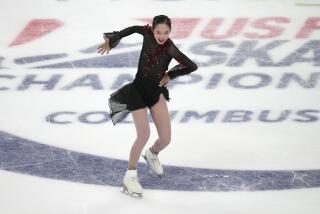Hughes Arrives -- Emily, That Is
- Share via
TURIN, Italy — They look alike, they talk alike, and each had her hair restyled and enhanced with face-framing highlights before competing at the Olympics.
There are enough similarities between 2002 figure skating gold medalist Sarah Hughes and her 17-year-old sister, Emily, that it wasn’t surprising when a reporter addressed Emily as “Sarah” during a news conference on Friday that marked Emily’s arrival to replace the injured Michelle Kwan.
“We have a good relationship,” Emily Hughes said of her sister, after reminding the assembled journalists that she’s not Sarah.
“She’s so supportive of my skating, as I was of hers. But we’re not competitive with each other. We’re both competitive -- that’s why we’re in figure skating.”
She acknowledged she has been caught up in a whirlwind since she learned Kwan had withdrawn and that she’d spend her winter break from Great Neck North High at the Olympics. Hughes got the news Sunday and arrived in Turin late Thursday, in time to watch the men’s long program at the Palavela.
Hughes finished third at the U.S. championships last month in St. Louis and was named an Olympic alternate when U.S. Figure Skating officials granted Kwan a medical bye onto the team. They affirmed Kwan’s Olympic berth after a test skate on Jan. 27, but Kwan injured a groin muscle during her first practice in Turin and pulled out Sunday. That has led Hughes to change her focus from next month’s World Championships to the Olympic short program Tuesday and long program Thursday.
“The Olympics are such an unexpected competition for me,” said Emily, who wouldn’t reveal anything about her routines except that she would wear a blue dress. “I’m just going to go out there and skate my best. You never know what’s going to happen. My practices have been going really well.”
Sarah Hughes, now 20, will arrive with the rest of the family in the next few days, but Emily said Sarah had offered her advice.
“Sarah says to have fun and just enjoy everything,” Emily said, “and so far, that’s what I’ve been doing.”
*
(BEGIN TEXT OF INFOBOX)
Go figure
After the 2002 judging scandal in figure skating, sport officials instituted a system aimed at removing judging bias. The new system computes the sum of three scores - base value, grade of execution and deductions - for the final score.
Base value
What is it?
A pre-assigned value based on the difficulty of a move - also called an element. More challenging elements rate higher base values.
Officials
The technical panel: Three competition officials monitor the competition and program elements. All three are monitored through audiotapes and videotapes.
Technical specialist: Identifies the element being performed - such as a jump, spin or spiral - and its level of difficulty. Calls out the base value.
Technical controller: Can overrule a call made by the technical specialist.
Assistant technical specialist: Serves as backup and supports technical specialist.
+
Grade of execution (GOE)
A value of plus or minus three added to base value. The better the performance, the higher the value.
Keeping judges anonymous
12 judges total
Three judges randomly eliminated by computer
Highest and lowest scores eliminated
Scores of remaining seven averaged for GOE and added to base value
How skaters are judged
Skating skills: Edge control, flow over ice surface, acceleration
Transitions/footwork: Difficulty, intricacy
Performance/execution: Physical, emotional, intellectual involvement
Choreography: A developed, intentional arrangement of movement
Interpretation: Personal and creative translation of music to movement
-
Deductions
There are no penalties or deductions except for program length or other violations. Skaters simply receive fewer points.
=
Final score
The sum of the base value, grade of execution and deductions
*
Source: USfigureskating.org. Graphics reporting by Joel Greenberg
More to Read
Go beyond the scoreboard
Get the latest on L.A.'s teams in the daily Sports Report newsletter.
You may occasionally receive promotional content from the Los Angeles Times.







